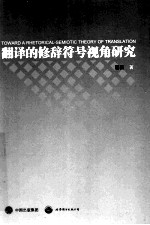

翻译的修辞符号视角研究 英文版PDF电子书下载
- 电子书积分:10 积分如何计算积分?
- 作 者:曹磊著
- 出 版 社:北京/西安:世界图书出版公司出版社
- 出版年份:2013
- ISBN:9787510053610
- 页数:234 页
Chapter 1 Introduction 1
1.1 Origin and Rationale for the Present Study 1
1.2 Definitions of Key Terms 10
1.3 Objectives of the Research 12
1.4 Methodology 14
1.5 Organization of the Dissertation 16
Chapter 2 Literature Review 19
2.1 About Translation Studies 19
2.1.1 Definition and Development of Translation Studies 19
2.1.2 Integrated and Interdisciplinary Approaches to Translation Studies 21
2.1.2.1 Integrated Approaches to Translation Studies 22
2.1.2.2 Interdisciplinary Approaches to Translation Studies 24
2.1.3 Non-Western Traditions in Translation Studies 28
2.1.4 New Trends 31
2.2 Issues and Debates in Translation Studies 31
2.2.1 Equivalence 31
2.2.1.1 Nida's Concept of Formal Equivalence 31
2.2.1.2 Nida's Concept of Dynamic Equivalence 33
2.2.1.3 Other Concepts of Equivalence 36
2.2.1.4 Summary 39
2.2.2 Context in Translating 39
2.2.2.1 Register Analysis 41
2.2.2.2 Context and Translation 44
2.2.2.3 Summary 46
2.2.3 The Translator's Role 47
2.2.3.1 The Translating Process 48
2.2.3.2 Translatability and Untranslatability 49
2.2.3.3 Foreignization and Domestication 50
2.2.3.4 Summary 51
Chapter 3 Toward a Rhetorical-Semiotic Approach in Translation Studies 53
3.1 Key Concepts in Semiotics 54
3.1.1 The Meaning of Signs 56
3.1.2 Semiotics 58
3.1.2.1 De Saussure's Sign System 61
3.1.2.2 Peircean Signification System 63
3.1.2.3 Roland Barthes'Notion 67
3.1.3 Semiotic Science 68
3.1.3.1 Logical Semiotics 68
3.1.3.2 Linguistics as a Branch of Semiotics 69
3.1.3.3 Syntax,Semantics and Pragmatics 70
3.1.3.4 Semiotics of Texts 71
3.2 Semiotic Approach toward Rhetoric 71
3.2.1 The Revival and Development of Western Rhetoric 71
3.2.2 Peirce's Rhetorical Turn 73
3.2.3 Semiotic Approach toward Rhetoric 78
3.3 Toward a Rhetorical-Semiotic Approach in Translation Studies 82
3.3.1 Translation and Semiotics 82
3.3.2 Rhetorical Translation Studies 87
3.3.3 The Translating of Meaning 92
3.3.4 Message Decoding and Encoding—the Process of Translation 94
3.3.4.1 Context 94
3.3.4.2 Code 97
3.3.4.3 Decoding and Encoding 98
3.4 Summary 100
Chapter 4 Rhetorical Encoding of Linguistic Signs 102
4.1 Communication,Linguistic Expressions and Rhetorical Encoding of Linguistic Signs 103
4.1.1 Characteristics of Communicative Activities 104
4.1.2 Definition of Rhetorical Encoding 106
4.1.3 Guidelines of Rhetorical Encoding 106
4.1.3.1 Conventions 107
4.1.3.2 Logic 107
4.1.3.3 Appropriateness 109
4.1.3.4 Pragmatic Purposes 110
4.2 Classification of Rhetorical Encoding 112
4.2.1 Logic Rhetorical Encoding of Linguistic Signs 112
4.2.1.1 The Category of Logic Signs 112
4.2.1.2 Basic Function of Logic Rhetoric 113
4.2.1.3 Meticulous,Compact and Intact Quality 114
4.2.1.4 Denotative and Monosemantic Referential Meaning 114
4.2.1.5 Objective,Reasoning and“Hot”Messages 115
4.2.2 Aesthetic Rhetorical Encoding of Linguistic Signs 116
4.2.2.1 Expressive Aesthetic Signs 117
4.2.2.2 Aesthetic and Emotional Functions 118
4.2.2.3 Flexible and Open Quality 123
4.2.2.4 Connotative Semantic Reference 124
4.2.2.5 Subjective,Emotional and“Cold”Messages 125
4.2.3 Semantic Rhetorical Encoding and Rhetorical Encoding of Linguistic Forms 128
4.2.3.1 Thoughts and Emotions 128
4.2.3.2 Linguistic Images 129
4.3 Summary 133
Chapter 5 Rhetorical Decoding of Linguistic Signs 135
5.1 Definition of Rhetorical Decoding 135
5.2 The Capabilities Required by Rhetorical Decoding of Linguistic Signs 135
5.2.1 A Thorough Knowledge of the Linguistic Sign System 136
5.2.2 Strong Capability of Logic Thinking and Reasoning 137
5.2.3 Strong Image Thinking Ability 139
5.2.4 Being Rhetorically and Artistically Accomplished 142
5.2.5 Correspondent Cognitive Abilities,Intellectual Level and Emotional Experience 144
5.3 Classification of Rhetorical Decoding 145
5.3.1 Logic Rhetorical Decoding of Linguistic Signs 145
5.3.1.1 Literal Logic Decoding of Linguistic Signs 146
5.3.1.2 Free Logic Decoding of Linguistic Signs 147
5.3.2 Aesthetic Decoding of Linguistic Signs 149
5.3.2.1 Semantic Interpretation 151
5.3.2.2 Image Aesthetic Appreciation 153
5.4 Summary 167
Chapter 6 The Retaining of Meaning in Translation from Rhetorical Semiotic Perspective 169
6.1 The Integration of Rhetorical Semiotics and Translation Studies 169
6.1.1 The Feasibility of Applying Rhetorical Theory to Translation Studies 169
6.1.2 The Construction of a Dynamic Meaning Theory of Translation 171
6.1.3 The Retaining of Meaning in Translation from Rhetorical-Semiotic Perspective 174
6.1.4 Summary 176
6.2 The Transfer of Meaning 177
6.2.1 The Transfer of Linguistic Meaning 181
6.2.1.1 Orthographic and Phonological Barriers 182
6.2.1.2 Grammatical Barriers 186
6.2.1.3 Barriers of Figures of Speech 189
6.2.2 The Transfer of Referential Meaning 191
6.2.3 The Transfer of Pragmatic Meaning 195
6.2.3.1 Cultural Words and Expressions 197
6.2.3.2 Idioms 203
6.2.3.3 Figures of Speech 205
6.2.3.4 The Reproduction of Register and Other Codes in Translation 208
Chapter 7 Conclusions and Implications 215
7.1 Major Findings and Contributions of the Study 215
7.2 Limitations of the Study 218
7.3 Areas for Further Research 219
Bibliography 221
Acknowledgements 233
- 《英汉翻译理论的多维阐释及应用剖析》常瑞娟著 2019
- 《信息系统安全技术管理策略 信息安全经济学视角》赵柳榕著 2020
- 《大学英语教学的跨文化交际视角研究与创新发展》许丽云,刘枫,尚利明著 2020
- 《卓有成效的管理者 中英文双语版》(美)彼得·德鲁克许是祥译;那国毅审校 2019
- 《当代翻译美学的理论诠释与应用解读》宁建庚著 2019
- 《社会文化系统中的翻译》姜秋霞,杨正军 2019
- 《2020考研英语大趋势 历年真题完形+翻译+新题型精讲精练》商志 2019
- 《AutoCAD 2018自学视频教程 标准版 中文版》CAD/CAM/CAE技术联盟 2019
- 《跟孩子一起看图学英文》张紫颖著 2019
- 《潜文本的阐释与翻译》刘早著 2019
- 《TED说话的力量 世界优秀演讲者的口才秘诀》(坦桑)阿卡什·P.卡里亚著 2019
- 《小手画出大世界 恐龙世界》登亚编绘 2008
- 《近代世界史文献丛编 19》王强主编 2017
- 《课堂上听不到的历史传奇 世界政治军事名人 初中版》顾跃忠等编著 2015
- 《指向核心素养 北京十一学校名师教学设计 英语 七年级 上 配人教版》周志英总主编 2019
- 《365奇趣英语乐园 世界民间故事》爱思得图书国际企业 2018
- 《近代世界史文献丛编 36》王强主编 2017
- 《北京生态环境保护》《北京环境保护丛书》编委会编著 2018
- 《近代世界史文献丛编 11》王强主编 2017
- 《近代世界史文献丛编 18》王强主编 2017
